Associate Provost for the Arts
The arts at MIT have been an important presence during this past, difficult year. At the same time, there have been some major developments in resources, programs, and new initiatives. The Office of the Associate Provost for the Arts has also seen a number of changes.
Resources and Programs
Perhaps the most moving demonstration of the importance of the arts to the MIT community came with the playing of the recording of the Adagietto from Mahler's Fifth Symphony by the MIT Symphony Orchestra for the community meeting in Killian Court on September 12. Another initiative in response to the attack on the World Trade Center was the swift design and construction of the Memorial Wall near the Chapel on Kresge Oval.
Academic year 2002 also saw initiatives for collaboration with MIT/Italy and MIT/France. In conjunction with MIT/Italy, the associate provost for the arts sponsored a successful residency by Sergio Escobar, managing director of the Piccolo Teatro, who gave a public address on "Science and Theatre."
The associate provost for the arts and the Office of the Arts also co-sponsored a symposium on the play "Copenhagen" with the Goethe Institut. Moderated by Alan Brody, the panelists included Laszlo Tisza, MIT professor of physics, emeritus; Gerald Holton, Harvard professor of physics, emeritus; Jochen Heisenberg, professor of physics, University of New Hampshire; and actors Mariette Hartley, Len Cariou and Hank Stratton of the Boston production. The audience filled Wong Auditorium to overflowing and an equally large number watched the stream in the lounge. Lynn Heinemann of the Office of the Arts was responsible for the coordination of the event and did a superb job.
Fall 2001 also saw a pilot project for the Freshman Arts Seminar and Advising Program. It consisted of three sections headed by Alan Brody; Martin Marks, senior lecturer in music; and Jane Farver and Bill Arning of the List Visual Arts Center (LVAC). The program received support from the d'Arbeloff fund to expand to five sections in fall 2002.
The MIT Museum opened its most significant exhibit to date, "Mind and Hand," focusing on the experience of the MIT student through history. Deborah Douglas, curator of the exhibit, is currently adding a section on the arts.
It was agreed that the plans for the Laboratory for the Performing Arts should be decoupled from the renovations of the Wiesner Building. Planning began for a new site, the selection of an architect, the creation of a steering committee, and aggressive fundraising for the $15 million project.
Exploratory meetings began in conjunction with the Program in Comparative Media Studies for collaboration with the Royal Shakespeare Company.
The Creative Arts Council met with the dean of undergraduate student life to develop a program for a visiting artist's residence in Simmons Hall.
The Office of the Arts sponsored the screening of Eric d'Arbeloff's film Phranc at the Boston Jewish Film Festival.
Associate provost for the arts Alan Brody gave the opening address, "Beckett and Nothingness: Levine and Somethingness," at the opening of professor of visual arts Ed Levine's exhibition of photographs "Waiting for Godot" at the Boston Public Library.
The Knight Foundation voted to renew funding for the Museum Loan Network for another three years.
National Engagement and K–12
This was the second year of operations for Teachers as Scholars with double the number of seminars offered over the previous pilot year.
The associate provost for the arts contributed a chapter to "Passion and Industry: Schools That Focus on the Arts," a publication of the National Arts and Learning Foundation.
The List Visual Arts Center (LVAC) continued a team-taught course with the arts director of the Cambridge Rindge and Latin School, introducing high school students to opportunities for careers in the arts. The LVAC also hired a full-time educational outreach coordinator.
The MIT Museum expanded its offerings to K–12 groups and hired Signe Pereira as director of educational programs.
The associate provost for the arts continued to serve as the MIT representative on the board of trustees of the Museum of Fine Arts and a member of the Education Committee of the board. He also joined the board of advisers for Teachers as Scholars.
Changes and Transitions
For family reasons, Jane Pickering sadly announced her decision to take a position at the Yale Peabody Museum after four extraordinary years as director of the MIT Museum. A search committee has been formed to find her replacement.
Maureen Costello decided to apply for long-term disability and to leave her position as director of special programs after more than ten years of exemplary service. A search for her replacement has begun.
The arts also lost four major and much beloved figures during AY2002. David Epstein, professor of music and longtime conductor of the MIT Symphony, and Ed Cohen, senior lecturer in music and head of the composition program, died within months of each other.
Gyorgy Kepes, founder of the Center for Advanced Visual Studies, died in the fall. A well-attended memorial and celebration of his work occurred in Kresge Auditorium on June 9.
Finally, the MIT community also lost Walter Rosenblith, former provost and one of the early driving forces of the establishment of the Council for the Arts at MIT.
More information about the Office of the Associate Provost for the Arts can be found on the web at http://web.mit.edu/arts/associate_provost/.
List Visual Arts Center
The List Visual Arts Center's mission is to present the most challenging, forward-thinking, and lasting expressions of modern and contemporary art to the MIT community and general public in order to broaden the scope and depth of cultural experiences available on campus. LVAC's mission also is to reflect and support the diversity of the MIT community through the presentation of diverse cultural expressions. This is accomplished through four avenues: changing exhibitions of contemporary art in all media, by the most advanced visual artists working today, that take place in the LVAC galleries (E15); the permanent collection of art (comprising large outdoor sculptures, artworks sited in offices and departments throughout campus, as well as art commissioned under MIT's Percent-for-Art policy, which allocates funds from new building construction or renovation for art); the Student Loan Art Program, a collection of fine art prints, photos and other multiples, maintained solely for loan to MIT students during the course of the academic year; and extensive interpretive programs to offer the MIT community and the public various perspectives about LVAC changing exhibitions and MIT's art collections.
Current Goals
- Continue to present the finest international contemporary art that has relevance to the MIT community.
- Institute a new guest curator program.
- Preserve, conserve, and resite works from the permanent collection.
- Make needed alterations to the gallery spaces.
- Continue to increase audience both from MIT campus and from Boston area.
- Use new educator to increase cross-disciplinary and collaborative use of LVAC's exhibitions, programs and facilities.
Accomplishments
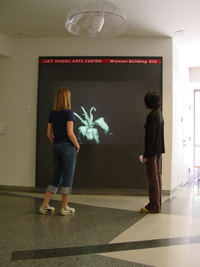 "Spinning" at the Media Test Wall. Photo by John Buck. Courtesy of the List Visual Arts Center. |
- Increased attendance to 15,520, the highest numbers since 1994, when actual attendance counts replaced estimated figures.
- Offered weekly gallery tours led by an LVAC staff member on Wednesday and Sunday afternoons. The tours were open to MIT faculty, staff, and students, as well as the general public.
- Provided tours of exhibitions and the permanent art collection on campus to 96 groups.
- Implemented a new exhibit space, the Media Test Wall. This 8' x 8' rear-projection screen located in the hallway of MIT's Building 56 features a compilation of videos by contemporary artists that play in a continuous loop 24 hours a day.
- Made loans of approximately 200 artworks to various departments and individuals across the MIT campus.
- Offered the Wasserman Forum on Contemporary Art.
- Received more than 40 positive critical reviews for exhibitions, including reviews in the Boston Globe, Boston Herald, Boston Phoenix, Boston Metro, Boston Magazine, Harvard Crimson, Art on Paper, Art in America, Art New England, New Art Examiner, Arts Media, Artnews, Artforum, Parachute, Museums Boston, Tema Celeste, Time Out NY, Concierge, Technology Review, Bay Windows, Cambridge Tab, Surface Magazine, Takara Magazine, J Magazine, This Side Up!, WHERE Magazine, the Daily Yomiuri: International, South End News, Playbill, Patriot Ledger, Tech Talk, Arts Editor, AIU, WBUR, Rock & Roll Library, and numerous web publications.
- Completed a commission by artist Jorge Pardo to create a new work for the NW30 residence.
- Made purchases or received donations of 43 new works to add to the Student Loan Art Program, the majority of which were exhibited in the Stratton Student Center during the academic year. They will be cycled into the lending collection in the fall of 2002.
- Completed a comprehensive self-survey in preparation for the American Association of Museum's site visit and 10-year reaccreditation.
- Completed an inventory of all public art in the central zone of the MIT campus.
- Created and updated a color map of the MIT campus highlighting 27 major public art works
- Began a residency by artist Paul Pfeiffer in collaboration with the Artist-in-Residence Program of the Office for the Arts that permitted the artist to explore rapid prototyping and other technologies and that will culminate in an exhibition in early 2003.
- Debuted "Race in Digital Space" as part of the USC-MIT Conference on Race in Digital Space; the exhibition was subsequently presented at the Studio Museum in Harlem in New York City.
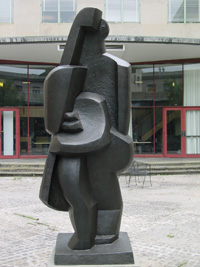 Jacques Lipchitz's "Bather" 1923-1925; bronze 76 x 29 x 28". Gift of Yulla Lipshitz in honor of Paul and Ruth Goncharov. Courtesy of the List Visual Arts Center. |
- Conserved Jacques Lipchitz's "Bather" and reinstalled it in the Hayden Courtyard.
- Completed final reinstallation of Jean Ipousteguy's "Cenotaphe," which had been conserved in 2000.
- Conducted an accessibility survey of the galleries with Very Special Arts (VSA) Massachusetts.
- Hosted a gallery exhibition tour for MIT Council for the Arts members during their annual meeting.
- Participated in the Freshman Arts Program Orientation and Campus Preview weekend programs, providing tours and receptions.
- Facilitated the List Essay Prize for writing on contemporary visual art, which was won by undergraduate Tina Lin.
- Implemented the second year of ArtWorks, a program in conjunction with Cambridge Rindge-Latin School. This after-school program provided tours and seminars for students interested in careers in the arts. Students met with the director, curators, registrar, and exhibition designer at the List Center, toured the MIT Media and Glass Labs, and visited facilities and met with staff of other Boston-area institutions, including the Museum of Fine Arts, Harvard Conservation Labs, architects Sasaki Associates, and web-design firm Partners and Simons. This program was so successful that Rindge-Latin has asked that it be repeated annually.
- Amended the Collections Management Policy to include a code of ethics and statements regarding the Native American Graves Protection and Repatriation Act and the acquisition of objects of Nazi-era provenance.
Exhibitions
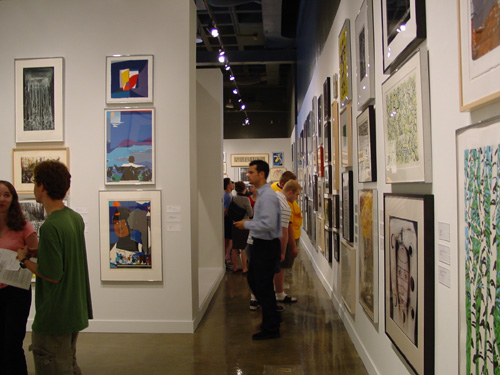 Student Loan Art Exhibition. Photo by Hiroko Kukuchi. Courtesy of the List Visual Arts Center. |
"Student Loan Art Exhibition" (LVAC galleries, September 4–16, 2001). Annual exhibition of 350 works comprising the Student Loan Art Collection. MIT students may view displayed works and then enter a lottery to be awarded the work of their choice on loan for the academic year to hang in their dormitory, apartment or office.
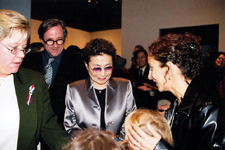 Yoko One at the opening of "YES YOKO ONO." Photo by Bridge Murphy. Courtesy of the List Visual Arts Center. |
"YES YOKO ONO" (LVAC galleries, October 18 through January 6, 2002). Organized by the Japan Society, this was Yoko Ono's first American retrospective. The popular exhibition offered a comprehensive reevaluation of Ono's prolific 40-year career, exploring her position within the postwar international avant-garde and her critical and influential role in originating forms of avant-garde art, music, film, and performance.
"Competitive Edges" (Media Test Wall, Building 56, January through April, 2002). This rear projection screen, located on the ground floor of MIT's Whitaker building, brings art out of the gallery where it can be encountered 24 hours a day by the MIT community and visitors. This first program was a thematic compilation of videos by Risk Hazekamp, Jesal Kapadia, Ingeborg Lüscher, and Euan Macdonald that looked at competition from a variety of viewpoints.
"AA Bronson: Mirror Mirror" (LVAC galleries, February 7 through March 31, 2002). This was Bronson's first solo exhibition in New England since General Idea, his 25-year collaboration in art and life with Felix Partz and Jorge Zontal, ended when they died of AIDS in 1994. The exhibition included photographs, installation works, wall paintings, and video. The exhibition was accompanied by an artist-designed catalogue including an introduction by LVAC curator Bill Arning, who organized the exhibition.
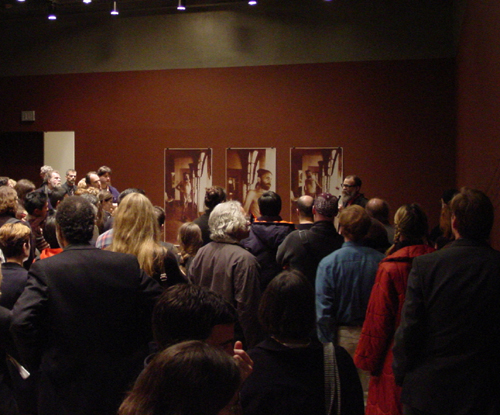 Artist AA Bronson leads a gallery tour of "Mirror Mirror." Photo by Hiroko Kikuchi. Courtesy of the List Visual Arts Center. |
"tele-journeys" (LVAC galleries, May 2 through July 7, 2002). MIT professor and internationally recognized artist Joan Jonas and List Visual Arts Center director Jane Farver organized "tele-journeys." The exhibition, which included single channel videos, sound, films, and video installations, focused on young artists from around the world who are living and working in Western Europe while expanding the vocabulary of performance- and installation-based conceptual art. It featured artists Carlos Amorales, Mark Bain, Yael Bartana, Michael Blum, Nabila Irshaid, Runa Islam, Sebastian Diaz Morales, Tomoko Take, and Fiona Tan. The exhibition was accompanied by a catalogue with an essay by independent curator and critic Jens Hoffmann and introductory remarks by Joan Jonas and Jane Farver.
"Spinning" (Media Test Wall, Building 56, May through present). The second installment of the Media Test Wall, this series, selected by Yasu Nakamori, examined 10 works that use spinning movements and circular/spherical figures in contemporary video. The international artists presented were Marco Brambilla, Ursula Scherrer and Michael J. Schumacher, Hiroshi Ono, Hussein Chalayan and Marcus Tomlinson, Jeroen Kooijmans, Magnus Wallin, Bruce Yonemoto, Koki Tanaka, Spencer Baker, and Rico Gatson.
Interpretive Program Highlights
LVAC curatorial and education staff led 96 gallery tours for such groups as the Visual Arts Program at MIT, the Council for the Arts at MIT, Artists Behind the Desk, MIT's Asian Studies Program, the School of the Museum of Fine Arts, Mass. College of Art, Rhode Island School of Design (RISD), the Art Institute of Boston, University of Massachusetts-Boston, Harvard University, Emerson University, Suffolk University, Dreyfuss University, Boston University, Gordon College, New England School of Art and Design, Tufts University, Pratt Institute, Elderhostel of Museum of Science, Spring House (Brookline MA), Carnegie Museum, St. Scholastic Academy (Colorado), University of Massachusetts-Amherst, Polter Road School, Boston Aquarium staffers, and the Stockholm School of Economics.
The Annual Max Wasserman Forum on Contemporary Art was attended by 422 people. The panel discussion was titled "Losing the Revolution: A discussion on the loss of seditious potential when avant-garde art and rock music stopped sleeping in the same bed." Andrea Miller-Keller served as moderator for a panel made up of Laura Cottingham, Dan Graham, Dick Hebdige, and Paul Miller a.k.a. DJ Spooky (That Subliminal Kid). The donor considered this to be the most successful forum to date.
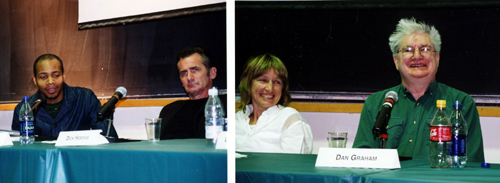 Wasserman Forum panelists DJ Spooky, Dick Hebdige, Laura Cottingham, Dan Graham. Courtesy of the List Visual Arts Center. |
Arts Boston Critical Dialogues (ABCD) presented a panel discussion, "The Anomalous Museum: Arts Spaces in Institutions of Higher Learning," moderated by Bill Arning. Panelists included Laura Donaldson, acting director, Gallery and Visiting Artists Program, Monsterrat College of Art, Beverly, MA; Joe Ketner, director, Rose Art Museum, Brandeis University; Linda Norden associate curator of contemporary art, Fogg Art Museum, Harvard University; Judith Tannenbaum Richard Brown Baker Curator of Contemporary Art, Museum of Art, RISD.
Lecture by Andrea Zittel, co-sponsored with the School of the Museum of Fine Arts, Boston.
"YES YOKO ONO": A lecture by Yoko Ono about her work was held in the Bartos Theater, with a live telecast available in Room 26-100. Min Tanaka, Japanese Butoh dancer, presented a solo dance recital to Ono's music in the atrium of Building E15.
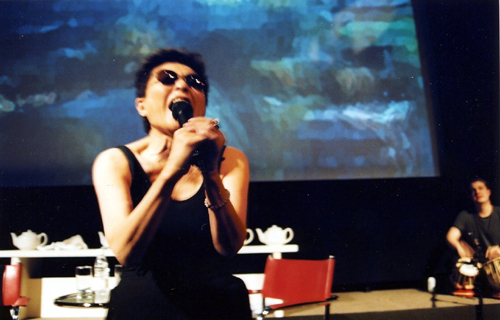 Yoko Ono performs and lectures about her work. Photo by Bridget Murphy. Courtesy of the List Visual Arts Center. |
"AA Bronson: Mirror Mirror": The artist AA Bronson hosted a walk-through of the exhibition offering the public personal insight into his works. Curator Bill Arning presented a walk-through of the exhibition on three separate occasions. A lecture given by Robert Atkins, New York–based art historian, columnist for The Village Voice, and author of ArtSpeak: A Guide to Contemporary Ideas, Movements, and Buzzwords, among other books, was entitled "The Artworld, Community and Activism: A Meditation Inspired by the Events of September 11th." An evening of videos by General Idea was held in the Bartos Theater.
"tele-journeys": A panel discussion featuring the exhibiting artists was held in conjunction with the MIT Comparative Media Studies Program. LVAC director and co-curator Jane Farver presented a walk-through of the exhibition. The exhibiting artists visited three classes and four student-artist studios in the MIT Visual Arts Program.
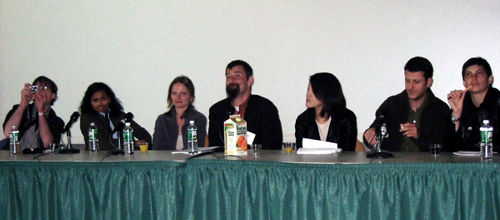 "tele-journeys" panel discussion. Photo by Jane Farver. Courtesy of the List Visual Arts Center. |
Collections
Permanent Collection
There were 12 gifts of art to the collection, including works by Ann Hamilton, Dennis Oppenheim, John Coplans, Amanda Means, Joseph Beuys, and Roxy Paine. Donors included Vera G. List, Herbert and Susan Bard, John Coplans, and an anonymous donor.
Percent for Art
With many major new MIT construction and renovation projects underway, curator Kathy Goncharov oversaw the continued development of several artworks. Jorge Pardo's ceiling piece in NW30 opened in the fall, while construction is well underway for works by Matthew Ritchie in the Zesiger Sports and Fitness Center and Dan Graham in the Simmons Hall dormitory. Photographs by Candida Hofer were purchased for the Department of Aeronatics and Astronautics, while teams have been organized to develop art programs for the Sidney Pacific dorm and the Vassar streetscape.
Student Loan Art Program Collection
The Student Loan Art Program attracted 1,183 MIT students to the LVAC gallery over the period of the exhibition of artworks. A total of 533 students submitted entries to the lottery to borrow artwork and approximately 285 works were disbursed. A special website dedicated to this program was begun by staff and will be completed during the summer of 2002.
Administrative Changes
- Formed Collections and Development Committees composed of Advisory Council and staff members.
- Instituted weekly long-range planning meetings for staff.
- Restructured staff to include one curatorial position dedicated to collection and percent-for-art projects and a position dedicated to education and outreach. These positions were filled by Kathy Goncharov and Hiroko Kikuchi.
- Provided training for 14 interns from Harvard, RISD, Tufts, Mass. College of Art, School of Museum of Fine Arts, Brown, Yale, Brandeis, and Boston University, as well as individuals who have previously completed school.
In addition, the LVAC director and curator took on the responsibility of providing academic counseling as freshman advisor to seven students. In this connection, several arts activities were held during the fall.
Finances/Funding
The Artworks Program received $10,000 from the Boston Foundation, $2,000 from the Sally and Milton Avery Foundation, and $1,700 from the Cambridge Arts Council.
"tele-journeys" received donations from the LEF Foundation of $8,000, while the British Council and French Cultural Services each gave $700. The Mondriaan Foundation supplied the exhibit with $16,500, the Dutch Consulate in New York donated $2,500, and the Netherland-America Foundation donated $2,000.
"AA Bronson: Mirror Mirror" received a donation in the amount of $42,187.50 from IMLS, MIT Council for the Arts supplied $23,600, Massachusetts Cultural Council donated $15,000, Fay Chandler gave $10,000, the Canadian General donated $2,200, and the Friends of Boston Art donated $1,304.61.
Michael Joo received funding from the LEF Foundation in the sum of $7,000.
Robert Sanders designated a $200,000 gift for MIT's Percent for Art Program.
Martin Zimmerman is awarding funds to permit the use of outside curators to supplement the List Center staff.
The Media Test Wall received an award from The John H. '29 and H. Naomi Tomfohrde Foundation of $9,500.
Save Outdoor Sculpture donated $700 to assess the condition of works commissioned in the 1980s for Building E15.
Donations in kind were received by: Royal Sonesta Hotel, Sapporo USA, Hotel at MIT, Cambridge SoundWorks, Sound Seal, Circa 50.com, Trader Joe's, Minuteman Press, Canadian Consulate General, Phoenix Media Communications Group, Four Seasons Greenery.
Future Goals
- Use LVAC web site to provide information about Student Art Loan Program (currently being developed) and permanent collection. Also to provide additional opportunities for artists to do web-based projects, beginning with Matthew Ritchie, who is creating a new work for the Zesiger Sports and Fitness Center under the MIT Percent-for-Art Program. This requires outside expertise and staff training.
- Develop comprehensive educational materials about all of the MIT Percent-for-Art projects. We would like to create documentary videotapes about the percent for art and artist residency projects. This requires additional funding and expertise.
- Develop comprehensive program of exhibitions and public programs consistent with MIT's mission that can attract large-scale funding.
- Expand upon the Media Test Wall's effort to present art in other sites on campus, beginning in the coming year with a small exhibition of works by contemporary Japanese artist Yukinori Yanagi for the MIT Japan Program offices.
- Develop web-based systems for providing self-guided tours and for implementing exhibition organization and better in-house communication.
Personnel Information
In March-April, director Jane Farver completed research begun with a grant from the Asian Cultural Council to travel to study new media art in Japan. She participated in grant-making panels for Etant-donnes for the Government of France in Paris and Los Angeles. She was a panelist for the Bogliasco Foundation (Genoa), conducted studio critiques, and met with graduate students and the School of the Museum of Fine Arts Boston. She has been invited to contribute essays to ART/Asia Pacific Magazine and an exhibition catalogue at the Americas Society in New York.
Curator Bill Arning presented lectures at Mass. College of Art, School of the Museum of Fine Art, the Institute of Contemporary Art in Boston, RISD, Cornell University, Virginia Commonwealth University, Brandeis University, and Montserrat College. He was a panelist or juror for the Boston Center for the Arts, the Silvermine Guild, and the New American Painting Journal. He contributed essays to catalogues produced by University of California at Riverside, Bard College, Art Pace, and the Museum of Salamanca. He also serves on the board of White Columns, ONI Gallery, and The Gallery at Green St.
Kathleen Goncharov has been brought on as curator of public art. She comes from the New School University in New York City, where she expanded the university collection from 200 to over 1,100 works in a variety of media. She has held numerous contemporary art positions around the globe, including curating sections of La Biennale Di Venezia and the seventh Triennale in New Delhi. She is the recipient of numerous grants, including a Peter Norton Foundation Research Grant, Curator-in-Residence at the Banff Centre for the Arts in Canada, and the NEA Museum Fellowship.
Advisory Board
Jenny Frutchy, was appointed the new chair of the LVAC Advisory Board Committee.
The following committees were established: Long Range Planning, Collections, and Development.
More information about the MIT List Visual Arts Center can be found at http://mit.edu/lvac/.
MIT Museum
The mission of the MIT Museum is to document, interpret, and communicate to a diverse audience the activities and achievements of the Massachusetts Institute of Technology and the worldwide impact of its innovation, particularly in the fields of science and technology; and to enhance the spirit of community inside the Institute through the promotion of dialog both at MIT and between the Institute and the wider world.
Highlights
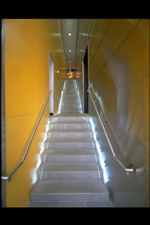 New staircase entrance at the MIT Museum. Photo by Peter Vanderwharker. |
The MIT Museum celebrated several milestones and achievements in AY2002.
We marked our 30th anniversary, as well as reaccreditation by the American Association of Museums for a ten-year period. Of the 8,000 museums nationwide, only about 750 are accredited, so the MIT Museum is proud to be part of this select group.
A reunion of Project Whirlwind alumni/ae was held at the museum in September 2001. More than 70 people attended the full day of events that included a special display of artifacts. The staff interviewed participants and accepted donations of photographs and other artifacts for the Science and Technology Collections. A reception acknowledging the donation of the Digital Equipment Corporation Historic Computer Collection to the museum by the Compaq Computer Corporation preceded a dinner sponsored by Mitre. Speakers included Jay Forrester, Robert Everrett and Kenneth Olson.
In October, as part of the Council for the Arts annual meeting, we unveiled a plaque acknowledging the major donors to our renovation project, and thanked all of the donors who helped to fund our new façade, dramatic stairway entrance, and visitor services area. This project has just received an Honor Award for Design Excellence from the Boston Society of Architects, International Interior Design Association, and the American Society of Interior Designers.
The museum served 37,713 visitors this year, including 2,992 children and parents who participated in our popular Family Adventures in Science and Technology and Friday After Thanksgiving Science Chain Reaction.
Collections
We completed the first phase of the renovation and refurbishment of our collections storage areas, which included the installation of roller-racking storage units in one area. Once the latter were installed, our painting and half-hull model collections were rehoused in this superior system. With a grant from the National Endowment for the Humanities, we hired a consultant to conduct a conservation assessment of the most significant films in our media collection. As part of this project, over 200 films were processed, cleaned, and inventoried in the database that has been created for the MIT General Film Collection.
We drafted policies governing collecting, including guidelines for the types of personal effects that will be acquired for the MIT General Collection, and collecting strategies for the Holography Collection. The Collections Committee and director approved seven new acquisitions, including a 19th century alidade used by MIT students from 1880 to 1945; the track ball invented by a Lincoln Laboratory researcher working on the BMEWS (Ballistic Missile Early Warning System) project and considered an antecedent to today's computer mouse; and a model of the control room for the Whirlwind computer. The registrar and collections manager processed 17 loans, including nine incoming loans for museum exhibitions, and eight loans out to the National Academy of Sciences, Edgerton Explorit Center, Peggy Notebaert Nature Center, Hotel at MIT, and MIT campus locations.
Architecture and Design Collections
The search for a curator of architecture and design was completed in the spring, and Gary Van Zante, presently curator of the southeastern architectural archive at Tulane University, has been hired and will join the staff in September. In the interim, Nicole Lapenta, a trained archivist, has been working with us on a temporary basis and has provided invaluable assistance to researchers. She has also worked on an Institute of Museum and Library Services (IMLS) Conservation Project Support grant to organize and process the Marjorie Pierce '22 Collection of architectural drawings, and to organize and inventory the Professor Richard Filipowski Collection of paintings, drawings, sketches, architectural drawings and sculptures.
Hart Nautical Collections
A variety of new exhibits, programs and collections management activities were initiated. "Perils of the Sea," an exhibition of prints from our Arthur H. Clark Collection, opened at the museum in March and will run through November. It was organized with the assistance of a retired curator from the Boston Museum of Fine Arts who contributed hundreds of volunteer hours of research time. A series of seven evening lectures featuring an STS graduate student and an MIT Sea Grant AUV (autonomous underwater vehicle) lab manager, among other speakers, is being offered in conjunction with the exhibition. The first phase of planned upgrades to the Ocean Engineering exhibition in the Hart Nautical Gallery was completed with the construction of a highly accurate mock-up of a full- AUV. Professor Chrys Chryssostomidis and his Sea Grant AUV Lab staff made this possible by making obsolete parts available and by advising museum staff on the correct procedures for assembly. The third year of our IAP "boat building" program, held in January, was the most successful ever. The course was retooled into two shorter classes on building half-hull models and lofting plans for construction. Plans from Hart for the original Tech Dingy by Professor George Owen were used for both classes. Sixteen students utilized the Department of Architecture's woodshop to make their models and loft the Tech Dinghy. John Lednicky '44 OE helped to fund these exhibitions and classes through a generous gift.
We made progress on improving collections access. The entire collection of over 250 half-hull models was recataloged and digitally imaged in the process of moving them from temporary storage to a new state-of-the-art compact storage room funded by the Institute. In June a volunteer intern from the International Yacht Restoration School began a project to catalog and digitally image a small but rare and previously uncataloged plan collection.
The collections continue to be heavily used with about 1,000 inquiries received via phone, fax, e-mail and regular mail.
Holography Collections
The museum is completing a project to provide autonomous, online access to the Holography Collection for its international audience. Working with support from Information Systems and an independent consultant, the database, which includes images, is currently a password-protected site so that data can be verified and the structure evaluated by the likely principal users in the international holographic community. After this stage it will be opened up to a wider audience. It will be inviting, image-centric, non-intimidating, browsable and searchable, and include links to other web sites, particularly those related to holography education, including "Eye on Holography," which is being developed by our Learning Technologies Coordinator. The latter will expose museum visitors to holographic tools and applications, thus helping them to better understand the processes, products, and implications of holography.
This year we also began the cataloging and housing of the recently acquired collection of holograms by the late artist Anait Stephens. And we worked with Color Scope Productions and the Spatial Imaging Group of the Media Lab on a documentary film on holography and the work of Professor Steve Benton that features holograms from our collection.
Photograph and Film Collections
Staff received and responded to over 300 requests for information about the photograph and film collections, including 100 requests for photographs. In addition, there were 80 research visitors. These collections have been used extensively by MIT departments and offices, in particular, as a visual resource for expanding departmental web sites. The collections also proved to be a significant resource to mark the 50th anniversary of the Sloan School and Center for International Studies.
The collections supported local initiatives such as the Boston History Collaborative's development of an "Innovation Odyssey" tour. They also are a resource for the academic and popular press such as the Washington Post and Smart Computing. Popular topics of interest have included Thomas Kuhn and John Nash. They were used in a wide variety of publications from textbooks on basic electronics to academic studies of the Air Force during the Cold War.
Science and Technology Collections
Work on "Phase II" of the "Mind and Hand" exhibition began. The final section of the exhibition will be redesigned to incorporate a unit on the humanities, arts and social sciences. More than a dozen distinguished faculty and staff members participated in two seminars to help conceptualize the design. Research and planning for a short-term exhibition based on the collection of 18,000 negatives illustrating the work of the MIT Radiation Laboratory was begun. It will open in November and run through May 2003. Planning for an exhibition on the history of aviation in New England (with a special emphasis on MIT) was initiated in May. This will be a collaborative project involving MIT faculty, students and alumni/ae as well as numerous aviation organizations, including the Aero Club of New England, the American Institute of Aeronautics and Astronautics and the Federal Aviation Administration. It will open in December 2003 and be on view through June 2004, and will be accompanied by a full series of education and public programs.
The curator responded to over 150 inquiries about artifacts and related archival materials. She assisted documentary programs for public television, including a significant project on Norbert Weiner and the influence of cybernetics on artists (German/French public television); the WGBH/Annenberg Foundation Series "Learning Math"; and photographers and authors from Mass High Tech, Toronto Globe Mail, NASA, and the Naval Undersea Warfare Museum. She also worked with a curator and exhibit planner from the Museum of Flight (Seattle, WA) through a grant from the Museum Loan Network.
Her work with the MIT community included a lecture to a class in Science, Technology, and Society (STS.001), supervision of an STS graduate student's independent study project, and participation in the MIT Center for the Study of Diversity in Science, Technology, and Medicine's "Research Workshop on 'Race' and/in the History of Technology." She also conducted special tours for Knight and Dibner Fellows.
Education and Outreach
This was a year of growth and development for the Education and Public Programs staff. With permanent funding from the Institute, we were able to hire Signe Pereira as our new full-time education coordinator. A National Science Foundation (NSF) grant awarded to the Media Lab for the Playful Invention and Exploration network, a three-year collaboration involving several museums throughout the United States, including the MIT Museum, is supporting Stephanie Hunt, our new learning technologies coordinator. These two positions have significantly increased our ability to develop, implement and expand programming.
Family Programs
The museum's monthly family program series, Family Adventures in Science and Technology (F.A.S.T.), and the Friday After Thanksgiving (F.A.T.) Science Chain Reaction with Arthur Ganson, continued to attract substantial media attention and record numbers of enthusiastic visitors. This year, hands-on F.A.S.T. programs were co-developed and generously staffed by students, faculty, and researchers from Materials Science (Glass Laboratory), Mathematics, Plasma Science and Fusion Center, Media Laboratory, Whitehead Institute and Leaders for Manufacturing Program. Together, F.A.S.T. and F.A.T. provided high quality, MIT-centered science and technology experiences for 3,000 visitors. F.A.S.T. has grown in popularity to the point where we have increased the number we are hosting, and F.A.T. has grown in size so that we now hold the event in duPont Gymnasium.
Through our partnership with the Media Lab in the Playful Invention and Exploration network, we were able to launch a twice-monthly series of programs called Invention Studios, utilizing emerging technologies. They introduce the public to the exploration of these technologies in new and highly innovative ways.
During the holiday weekend of January 19-21, we sponsored Cambridge Kids Free weekend. Invitations were distributed to all public elementary schoolchildren in Cambridge, and 706 students and parents visited us. We also offered drop-in programs during the February and April school vacation weeks. The February program, "Zoom into Engineering," was co-sponsored with the School of Engineering and WGBH Boston, and coincided with National Engineers Week. The April program, "Gear Heads," explored the world of mechanical sculpture and offered the opportunity for schoolchildren to create their own works using gears, cams, pulleys, motors and cranks. Both series were well attended with over 2,000 participants.
School and Group Programs
The museum's popular school and group programs served students throughout the state and greater New England. They have fostered an increase in the diversity of our audience by successfully extending our reach into communities traditionally underserved by museums. We have implemented regular programming targeting homeschoolers who have become a larger segment of our audience. Most of these programs revolve around three-day workshops in holography.
With the Public Service Center and the Office of Government and Community Relations, we launched a new approach to working more closely with the Cambridge Public Schools that will involve us in assisting in systemic change. In September we held our first Educator Open House and are planning to make this a regular event. Teachers from communities such as Rockport, Chelmsford and Framingham have visited with the express purpose of developing interdisciplinary teacher workshops through the museum. This year the Museum Institute for Teaching Science chose us to serve as a regional education partner, and this summer we will be serving 40 teachers from the Boston metropolitan area in their professional development institute focusing on modeling.
We continue to serve the needs of MIT faculty and students through cooperative programming for IAP, the MITE2S/SEED program, and support for student initiatives such as Collision 3 in 3D, a project of the Arts and Technology at Tech group.
Exhibitions
Main Facility
We have implemented a new plan for changing exhibitions in one of the main galleries. The first exhibition in this series is "Perils of the Sea," consisting of 19th century prints from the Hart Nautical Collection. We are currently in the planning stages for a new exhibition on holography that will include a traveling component.
Compton Gallery
The museum installed three new exhibitions in Compton Gallery. Collaborating with the Glass Laboratory, we developed and mounted "Incandescent Spirit," stunning experimental glassworks by the late Page Hazelgrove, which received a great deal of press interest and was ranked by the Boston Globe as one of the best exhibitions in Boston. We also hosted "MIT Lincoln Laboratory: Technology in Support of National Security," a 50-year retrospective of the lab's service to the nation in developing a program of research and development pertinent to national defense, with a particular emphasis on advanced electronics. The latest exhibition is entitled "eye," and consists of retina prints and poetry by Center for Advanced Visual Studies (CAVS) senior fellow Elizabeth Goldring. Goldring is a severely visually challenged artist whose work has special significance to other individuals who are visually challenged. This exhibition was designed with these audiences in mind, and includes an audio component of recorded poetry (read by Goldring) and large format text and labels.
Traveling Exhibitions
Two traveling exhibitions organized by the museum are touring museums throughout the United States: "Seeing the Unseen: Photographs by Harold Edgerton" and "Approaching Chaos."
Development
We raised $154,484 in gifts and pledges to support "Mind and Hand: The Making of MIT Scientists and Engineers," and the new arts and humanities section of this exhibition; new exhibitions in Compton Gallery; the Holography and Hart Nautical Collections; a conservation assessment of the film collection; the development of a master plan for the museum's public spaces; and for operating support. The Council for the Arts, Massachusetts Cultural Council, National Endowment for the Humanities, 21 individuals and a foundation comprised the group of generous donors. We will launch a Friends program this summer to broaden our base of support and to provide much needed operating and special project funds.
Visitor Services and Functions
A new visitor services area was created as part of the museum's renovation project, and was designed to incorporate a small retail line of merchandise that relates to exhibitions and programs. We have also partnered with the MIT COOP to develop the MIT Museum Collection that is available for purchase online or by telephone or mail order. Our functions business expanded greatly this year with the addition of a part-time staff member charged with developing this business. We are planning to increase promotion of our functions space to potential customers both within MIT and among the larger event planning community.
Personnel
Three new staff members were hired in the fall: Signe Pereira, education coordinator; Ryan Jimenez, part-time public relations and marketing coordinator; and Claudia Majetich, part-time visitor services and functions manager. Sue Speisman joined our staff in the spring as administrative assistant, succeeding Ellen Weene who left in December. Jane Pickering, who made extraordinary contributions to MIT and the museum as director for four years, resigned in May to move to Connecticut with her family. Mary Leen, the associate director, is serving as acting director while the search is underway for a new director.
More information about the MIT Museum can be found on the World Wide Web at http://web.mit.edu/museum/.
Museum Loan Network Program
The Museum Loan Network (MLN) facilitates the long-term loan of art and objects of cultural heritage among US institutions as a way to enhance the installations of museums, thus enabling them to better serve their communities. The MLN grant programs help museums respond to the increasing public demand for installations that are relevant to a range of age groups and cultural heritages and to provide better artistic, cultural and historical contexts for works on display. The MLN programs have led to the sharing of objects among different types of museums, fostering collaborations between institutions of varying size and discipline throughout the US. Funded and initiated by the John S. and James L. Knight Foundation and The Pew Charitable Trusts, the MLN is administered by MIT's Office of the Arts.
Program Development
The program continues to emphasize collaboration and the building of networked resources. The MLN's initiative to include a range of objects of cultural heritage previously outside its domain, continues to evolve. In 2000, the MLN piloted a collaborative program with the American Composers Forum (ACF). Entitled "Museums, Composer, and Communities" (MCC), this pilot program provides museums with an opportunity to work with composers and create new music for their communities. MCC grants were awarded to four institutions, bringing new music and the creative energy of composers directly into museums and their communities. With MCC, the MLN hopes to create new models for interdisciplinary collaboration and enhance the quality of the MLN projects involved in these partnerships. In January 2002, the MLN published and distributed "Museum as Catalyst for Interdisciplinary Collaboration: Beginning a Conversation" (MAC), proceedings of a series of convenings hosted by the MLN in 2000–2001. These meetings, which gathered innovative leaders from different disciplines, explored a number of interrelated issues, challenges and opportunities affecting collaboration and today's museum. It is the hope of the MLN that the conversations reflected in MAC will further the discourse on the role of collaboration and inspire museums to continue to explore new ways of working in their own communities.
Web Site
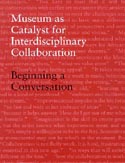 |
The MLN online directory, a practical means of identifying objects of cultural heritage available for long-term loan to eligible museums throughout the US, now contains 8,000 objects from 53 institutions. The MLN continues to keep track of the number of hits on the directory and on specific object entries, as well as the number of times each museum with a password has accessed the directory. So far, over 300 museums have obtained passwords to access and search the directory and since January 2000, approximately 7,000 hits have occurred on over 2,750 individual records. The MLN continues to develop virtual exhibitions on its homepage. Featuring projects made possible by MLN implementation grants and designed in conjunction with MIT's Educational Media Creation Center (EMCC), these virtual tours not only provide visual models for museums to understand how to creatively utilize MLN, but also stimulate public interest in the arts and provide greater access to museums' hidden permanent collections. In 2002, MLN's publication "Museum as Catalyst for Interdisciplinary Collaboration: Beginning a Conversation" was made available on MLN's web site in pdf format.
Press and Promotion
The MLN continues to work with communications consultant Resnicow/Schroeder, who was hired in the fall of 1998 to lead an aggressive press initiative. The MLN has been very pleased with the long term results of the initiative, which has yielded national and international press, including a feature article in the April 2002 issue of the Italian magazine Impresa Cultura.
In its continued effort to increase public awareness about the MLN and its sponsored projects, Resnicow/Schroeder has also been working closely with MLN grantees in trying to develop stories about their projects. The Pew Charitable Trusts highlighted the MLN with a ten-page color article in the summer 2001 issue of their magazine Trust. In November 2001, the American Composers Forum newsletter featured its second piece on the MLN-ACF partnership, "Museum, Composers and Communities," an article written by composer William Banfield, who is collaborating with the Mobile Museum of Art. The Billings Gazette in Montana also focused on the MLN-ACF pilot program through an article on the Western Heritage Center's project with composer Jim Cockey. The MIT Faculty Newsletter featured an article on the MLN in its October/November 2001 issue, which was circulated to 3,000 members of the MIT community. In addition, MLN projects were highlighted in numerous museum newsletters across the country.
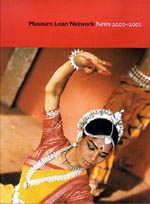 |
Museum Loan Network News 2000–2001 was printed at a run of 6,000 copies in October 2001 and distributed to museums, foundations and other organizations. This issue prominently focused on the MLN directory, featuring 36 objects from the database in the center foldout section. The MLN has continued to promote the directory and encourage museums to check it periodically for new additions.
In March 2002, an e-mail message was sent to the MLN mailing list encouraging them to use the directory and "make a new discovery." The response was very positive and there was a notable increase in usage and in password requests in the weeks following the e-mail.
The MLN director and/or program associates attended and/or lectured about the program and related museum issues at the following annual meetings: the American Association of Museums Meeting, Dallas, TX; the Grantmakers in the Arts annual conference, Lake Mohonk, NY; the New England Museums Association annual meeting, Newport, RI; the "Museums and the Web" conference, Boston, MA; as well as the IMLS "21st Century Learner" conference, Washington, DC. In the fall of 2001, the MLN director gave a presentation at MIT's Academic Council. She also presented an Arts Colloquium on the MLN, which was attended by MIT faculty and staff as well as members of the Council for the Arts. These presentations focused on the mutually beneficial relationship between the MLN and MIT and helped elevate awareness of the program within the MIT community.
Grants
The MLN awards three types of grants to eligible nonprofit institutions in the US: travel grants, survey grants, and implementation grants. At the January 2002 and June 2002 Advisory Committee meetings held at MIT, 40 grants totaling $797,845 were recommended for approval by MIT for funding to museums throughout the country. These awards will facilitate the sharing of a diverse array of objects among museums of differing sizes and disciplines. Grants were awarded to museums with budgets of $25,000 in counties with a population of 2,600 and to institutions with budgets of $52 million in counties with a population of 5.4 million. Survey grants will allow for a variety of objects to be added to the MLN directory, including Chinese American historical objects from the Chinese Historical Society of America, San Francisco, CA; African American paintings from the DuSable Museum of African-American History, Chicago, IL; French dolls from the Strong Museum, Rochester, NY; Latin American art from the Los Angeles County Museum of Art, CA; Pacific musical instruments from The Field Museum, Chicago, IL; Asian ceramics from the Smithsonian Freer and Sackler Galleries, Washington, DC; and business and advertising ephemera from The New York Historical Society, New York, NY. Travel grants were awarded to the Cheyenne and Arapaho Tribes of Oklahoma, Concho, OK; the National Underground Railroad Freedom Center, Cincinnati, OH; the Museum of Flight, Seattle, WA; and the Smith College Museum of Art, Northampton, MA, among others. Implementation grants were awarded to a broad range of institutions including the Cedar Rapids Museum of Art, Cedar Rapids, IA, for the loan of 152 Roman objects; the Pueblo of Jemez Museum of History and Culture, Pueblo, NM, for the loan of 120 Pueblo objects; the Railroad Museum of Pennsylvania, Strasburg, PA, for the loan of a railroad passenger coach; and The Skyscraper Museum, New York, NY, for the loan of the last remaining model of the World Trade Center. In addition, "Museum, Composer, and Communities" grants were awarded to the Cedar Rapids Museum of Art, Cedar Rapids, IA, and the Mobile Museum of Art, Mobile, AL.
Future Plans
The MLN will continue to explore new collaborative relationships (modeled on the ACF pilot partnership) to ensure its relevance to museums and their communities. The John S. and James L. Knight Foundation has approved renewed funding for the MLN over a period of three years starting in October 2002. The amount of the new grant is $2.75 million, including $250,000 for fundraising. The MLN has also submitted a proposal to The Pew Charitable Trusts seeking funding for 2002–2003. In the coming year, the MLN will be seeking new funding sources to ensure its long-term viability.
More information about the MLN can be found on the web at http://loanet.mit.edu/.
Office of the Arts
Council for the Arts
The academic year 2001–2002 began with the country, and much of the world, in shock after the terrorist attacks of September 11. The Council for the Arts at MIT was deeply affected, as many of our members lost colleagues and neighbors and had to cope daily with the view of a radically altered skyline as a constant reminder of the tragedy. Fortunately, none of our members or any of their immediate family members was lost.
This great tragedy, despite its resulting economic downturn, only served to strengthen the council's commitment to its mission: to foster the arts at MIT. The council had a successful year, as fundraising continued to be strong, and programs flourished.
One of the highlights of the year was an excursion to Seattle and Vancouver from May 23 to 27, attended by approximately 40 council members, spouses and friends.
Council Standing Committees
Annual Meeting (Patricia Chute, chair). The 29th Annual Meeting of the Council for the Arts at MIT took place on October 25 and 26, 2001, and was focused on the visual arts. Council members and guests were treated to a tour of the List Visual Arts Center's Yoko Ono retrospective exhibition, led by Curator Bill Arning. Other highlights included the installation of "Reflection Loop," an interactive sculpture featuring the eyes and beaks of 200 "furby dolls" by MIT graduate Kelly Heaton. Heaton received funds from the Grants Committee to create the piece. Council members also had a chance to visit the Glass Lab in Building 4, where they were greeted by Artist-in-Residence Peter Houk. Peter narrated a glassblowing demonstration given by MIT students. Director Ed McCluney then gave a tour of the Student Art Association in the Stratton Student Center.
The Annual Meeting dinner was held on Thursday evening, October 25, at the deCordova Museum in Lincoln, Massachusetts. Isaac Julien, the British installation filmmaker, was presented with the 2001 Eugene McDermott Award in the Arts. Jane Farver, director of the List Visual Arts Center, introduced Mr. Julien, who showed some clips of his recent work.
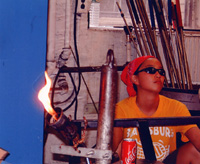 Council arts scholar and Plchuck Scholarship Recipient Helen Lee at the Annual Meeting. |
The Friday morning business meeting began with an address by President Charles M. Vest, who spoke of the crucial role the arts played in the MIT response to the September 11 tragedies. He described the MIT Symphony's contribution, as well as the partial scale model of the World Trade Center built by MIT architecture students as a memorial. He noted that the students immediately used the arts as a means of expression and a way to come to terms with the overwhelming series of events on that awful day.
A number of paintings and sculpture by council member Fay Chandler were on display during this portion of the meeting, and were enjoyed by all present.
Patricia Fuller of the List Visual Arts Center gave a presentation on public art at MIT, and showed us the sites of future works of art, pieces that are being commissioned as part of the MIT Percent for the Arts Program. Every new or renovated building on campus has a percent of its final cost put aside for a new work of art. With the current spate of construction going on, there will be many new pieces added to the collection, such as a Dan Graham for the new Simmons Hall dorm, a Jorge Pardo in the new graduate dorm, and possibly a Richard Serra for the Stata Center.
The Gyorgy Kepes Fellowship Prize was presented to Edward McCluney, director of the MIT Student Art Association (see Special Programs below) at the Annual Meeting luncheon on Friday, October 26 at the MIT Museum. The museum also held a brief thank-you ceremony for the donors who made the renovations to the museum's façade possible.
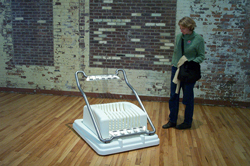 Council arts scholar Margaret Weigel, a graduate student in Comparative Media Studies, at Mass MoCA. |
Arts Scholars Committee (Brit d'Arbeloff, chair). The newest of the council's programs is finally hitting its stride, and the students who make up the group are gradually making it their own. A highlight of the program this year was a field trip, on January 26, to the Massachusetts Museum of Contemporary Art (Mass MoCA) in North Adams, in the western part of the state.
Communications (Pepi Weis, chair). The Communications Committee produced three issues of the council newsletter, Council Currents, to great success. Council Currents is written by council members, for council members.
Development (Daniel Vershbow '45, chair). As of this writing (6/24/02) the council has raised a total of $330,476 from council members, and a total of $12,105 from non-member donors.
Grants Program (Bradford M. Endicott '49, chair). The Grants Program of the Council for the Arts at MIT awarded 51 grants this academic year, totaling $89,828. Highlights included funding to help refurbish the furnaces in the MIT Glass Lab, support for an ambitious series of concerts of American music spearheaded by Lecturer Frederick Harris, a group exhibition of work by graduate students in the Visual Arts Program, and operating support for the student dance group Movements in Time.
Membership (Bernard G. Palitz '47, chair). As of this writing (6/24/02) council membership stands at 110, with six ex officio members and 104 regular members. The following new members have joined the ranks of the council since last July: Anne Bridge Baddour, Margaret Anne Cullum, Jennifer Frutchy, Melvin Meisinger, Theresa Stone '76, and Peter Wender '71. Sadly, two longtime council members passed away since the last Report to the President: Gyorgy Kepes and Walter A. Rosenblith.
Special Events Committee (Catherine N. Stratton, chair). On May 23, approximately 40 council members and guests gathered in Seattle, Washington, for the "Seattle-Vancouver Arts Adventure." The kick-off event was a cocktail reception at the studio of renowned glass artist Dale Chihuly, situated in a former boathouse. The group was treated to a glass blowing demonstration and the delightful display of the work of the Chihuly studio, as well as Mr. Chihuly's personal collections of a variety of artifacts and memorabilia displayed at the Studio building.
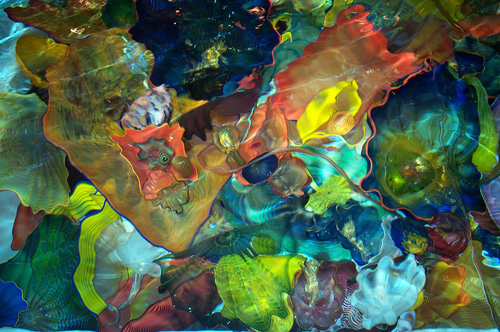 The bottom of the spectacular swimming pool at the Chihuly Studio. |
After this splendid start, the assembled enjoyed a tour of the Bellevue Art Museum, a visit to the private collection of Jane and David Davis, and a tour of the Microsoft corporate art collection. The group then traveled to Vancouver, where they met with Arthur Erickson, Canada's preeminent architect, and Martine Reid, widow of First Nations Haida artist Bill Reid. Mr. Erickson and Dr. Reid led a tour of the Museum of Anthropology at the University of British Columbia. Interleafed with brief rests and sumptuous meals, this five-day excursion was enjoyed by all.
Affiliated Committees
List Visual Arts Center (LVAC) Advisory Board (Jennifer Frutchy, chair). The LVAC board continues to be a valuable group of advisors to Director Jane Farver. Longtime chairperson Kitty Glantz stepped down this year, and Jenny Frutchy was chosen as her successor.
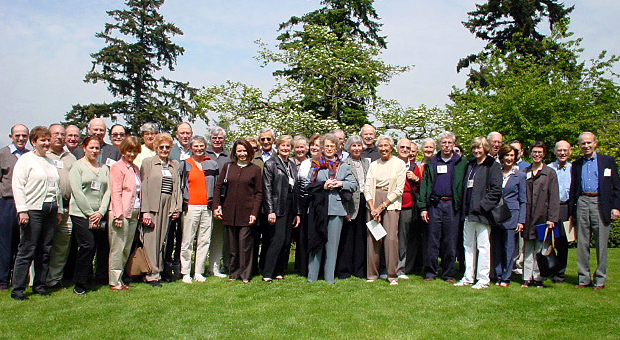 Council members and friends at the home of Jane and David Davis outside Seattle. |
MIT Museum Advisory Board (Harvey I. Steinberg '54, chair). Jane Pickering, who in her brief tenure as director re-focused the museum's mission and revitalized its programs, resigned in the spring of 2002. She has taken a position at the Peabody Museum at Yale. A search committee for her successor is being formed as of this writing.
Artist-in-Residence Committee (Stephen Memishian '70, chair). Organized along the lines of the MIT Museum and LVAC boards described above, this committee works with MIT Office of the Arts Director of Special Programs Maureen Costello and a panel of arts professionals, council members and artists to bring artists to the MIT campus to work throughout the Institute.
Special Programs
Since 1980, the council has underwritten MIT's enrollment in the University Membership Program offered by the Boston Museum of Fine Arts. This program provides free admission and discount benefits to all MIT undergraduate and graduate students, as well as ten membership cards for the daily use of MIT faculty and staff.
The free-ticket program with the Boston Symphony Orchestra continued this year. MIT students can obtain, with their student ID, free admittance to Thursday evening and Friday afternoon concerts on a day-of-show, stand-by basis. This year the BSO introduced a new method of ticket distribution, the BSO College Card. The council distributed over 1,500 cards to MIT undergraduate and graduate students. The number of cards and the swiftness with which they were snatched up (800 on the first day of distribution) speaks to the success of this unique program.
Similar programs have been established with other Boston-area orchestras, such as Collage New Music, the Boston Modern Orchestra Program, and the New York Collegium (which has a series of concerts at Jordan Hall).
The successful Student Performing Arts Excursions Series continued, with tickets to the following events made available at no charge to MIT students: a performance of "Othello" at the American Repertory Theater, "Shel's Shorts" (plays based on Shel Silverstein stories) at the new Market Theater in Cambridge, a performance by the Boston Philharmonic, a tribute concert to John Coltrane at Northeastern University, and a performance by the Wayne Shorter Group at the Berklee Performance Center.
The Gyorgy Kepes Fellowship Prize was presented by Angus MacDonald to Edward McCluney at the Annual Meeting luncheon on Friday, Oct. 26. At the Annual Meeting dinner at the deCordova Museum, the Eugene McDermott Award was presented by Dorothea Endicott (McDermott Award Committee chair) to Isaac Julien, an installation filmmaker based in London. Mr. Julien returned to campus in April to present a new film, and meet with several groups of students, as the residency portion of the McDermott Award.
At the Institute Awards Convocation on May 13, associate provost for the arts Alan Brody presented the Laya and Jerome B. Wiesner Student Art Awards to Nathan Fitzgerald '02 and Christopher Rakowski '02, both for achievement in music. The Louis Sudler Prize was presented to Kevin Choi '02 for his accomplishments in filmmaking.
The council established a new program, the Pilchuck Scholarship, at the request of the Glass Lab. One MIT student per year is chosen to attend a summer session at the Pilchuck Glass School outside Seattle, Washington. The council contributes half of the tuition; Pilchuck provides the balance. The first year's recipient was Helen Lee. This year, the scholarship will go to Chris Laughman.
More information about the Council for the Arts can be found on the web at http://web.mit.edu/arts/council/.
Arts Communication
In the 13th year of the Office of the Arts, Arts Communication continued to maintain and increase awareness of the arts at MIT both within and outside the Institute by publishing and distributing up-to-date information on MIT arts events and exhibitions; actively promoting arts-related activities, programs and people at MIT; and working with the Admissions Office to inform prospective students about the arts at MIT. Significant developments included the launching of the new MIT arts web site and production of a DVD on the arts at MIT.
Internal (MIT)
The newly designed MIT Arts web site was officially launched, generating praise from all quarters. Postcards announcing the site were sent to the entire campus as well as to individuals off-campus. The Office of the Arts also promoted the web site internally at a Lobby 10 publicity booth, where staff distributed newly produced Arts at MIT Post-It notes and bookmarks, and held a student raffle for new Arts at MIT T-shirts.
Mary Haller, director of Arts Communication, completed production of "Discover the Arts@MIT," a DVD of interviews and performance clips of creative endeavor around the Institute. The piece is to be used for student recruitment and general communication. The first wide-scale broadcast was for commencement guests prior to the start of the ceremony. Initial distribution went to the Creative Arts Council, selected members of the Council for the Arts at MIT, Artist-in-Residence committee members, and contributors to the project.
A new e-mail list was developed especially for those interested in announcements about MIT-related arts, free and discounted ticket offers, and information on special MIT arts events. Largely self-service, folks can subscribe or unsubscribe at any time at http://imap.media.mit.edu/mailman/listinfo/arts-announce/.
Haller hosted an Arts Reception during Campus Preview Weekend. The event, which took place in the Kresge Lobby, included performances by MIT student musicians and gave accepted applicants for the Class of 2006 a chance to meet faculty and current students and obtain information on MIT arts programs and opportunities.
Arts Communication handled the announcements and distribution procedures for a program offering free tickets to concerts by Metamorphosen, held regularly throughout the year. The National Public Radio program "From the Top" also offered tickets to all affiliated with MIT to two of their local tapings.
Lynn Heinemann maintained and publicized arts events on MIT's electronic web-based Events Calendar and maintained the Arts web site, updating calendar listings, publishing each week's Tech Talk arts stories and creating new links. The LED sign in Building 16, written and programmed by Heinemann, continues to generate attention with announcements of MIT arts events and activities. Heinemann also continued to produce the weekly "Arts Hotline" (617-253-ARTS) and provided materials for the new "Arts at MIT" kiosk in Lobby Seven.
Arts Communication continued to oversee ArtsNet, which consists of about 90 campus arts representatives.
Haller represented the arts as a member of the Communications Operations Group (COG), Information Group, and Administrative Council.
Student Recruitment and Communication
For the seventh year, MIT's admission application included tear-out postcards for prospective students to use to request information on the arts at MIT and indicate specific arts interests. Postcards were received from 1,008 individuals and a copy of the Arts@MIT booklet and a "freebie" flyer were sent to each with a letter from associate provost for the arts Alan Brody.
Tech Talk Coverage
For the 13th year, Arts Communication provided text and images for the Arts Page in Tech Talk. Material for 24 feature Arts Pages and eight Month-at-a-Glance Arts Pages (including three two-pagers) was compiled and written by Heinemann and edited by Haller; both worked closely with the staff of MIT's News Office. Month-at-a-Glance Arts Pages were mailed monthly to 624 individuals at their request.
Twenty-eight arts-related feature stories and six arts-related photos-with-captions were published in Tech Talk's general spaces, including one arts story and four arts photo-captions on the front page. Activities and individuals involved in arts were cited five times in the "Awards and Honors" column. Heinemann was the primary writer; other contributors included Christina Jensen (a new staff member shared with the Music Section), Haller, members of the News Office staff and members of the MIT arts community.
Selected Media Attention
The following are some of the headlines publicizing people and projects across the Institute as a result of press releases and publicity efforts initiated by Arts Communication:
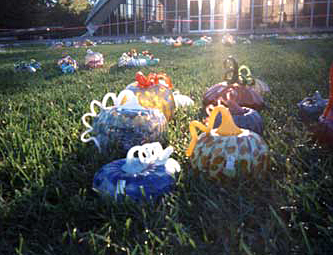 MIT's Great Glass Pumpkin Patch in Kresge Oval, September 15–16, 2001. Photo by Nicholas Fuhrer. |
MIT "Great Glass Pumpkin Patch" will dazzle the eye, benefit MIT's Glass Lab—Sept 15–16.
MIT Announces Visiting Artists for Fall 2001
Playwright/director Moisés Kaufman Presents Free Talk at MIT Oct 4
MIT presents Balinese puppeteer Wayan Wija in world premiere of "Shadow Bang," October 12–14
Linda Tillery and the Cultural Heritage Choir at MIT October 21
Filmmaker Isaac Julien to receive McDermott Award from MIT
MIT Media Lab exhibition examines technology's transformation of portraiture
MIT Wind Ensemble premieres "Coyote's Dinner"
MIT Professor John Maeda wins National Design Award from Smithsonian's Cooper-Hewitt
MIT presents American Music Series March 2–May 10, 2002
MIT Hosts Symposium on Michael Frayn's play "Copenhagen"
Other Media Attention
"What kind of project would an artist-in-residence at MIT come up with?" asked ABC Nightline executive producer Leroy Sievers. The July 6, 2001, broadcast featured a report by Robert Krulwich on Joe Davis, research affiliate in the Department of Biology and included a look at Davis's paramecium fishing contraption—deep sea fishing equipment mechanically rigged to a drop of pond water. "[Davis] comes up with all sorts of ideas that no one ever thought of before, and then enlists the considerable brain power there to turn them into reality," said Sievers. "I've always believed that part of our job as journalists is to take people places they've never been, and to show them things they've never seen," he continued. "I guarantee you that you have never seen anything like this before."
A feature article in the Boston Globe Calendar touted the MIT Chapel as a "small gem … little known to the public although designed by a once famous architect, Eero Saarinen, in 1955…. Once you're inside, you're in a wondrous place. You hear the lapping sound of invisible water. Outdoor light bounces off the water and comes inside, flickering against undulating walls. You feel isolated from the world around you. No place in Greater Boston feels holier," wrote Robert Campbell.
Playwright/director Moisés Kaufman's residency at MIT was covered in length by the Boston Herald's Terry Byrne, who described an acting workshop class he conducts with MIT students. "The effort, he says, becomes about creating a performance more than simply performing a text," she wrote.
"Greater Boston Arts," WGBH-TV's monthly series on the arts, opens its sixth season in October, 2001, with a profile of Media Lab professor Tod Machover, whom they call an "inventor committed to bridging the gap between music and technology." The segment featured work being done at the Media Lab on interactive musical toys, including rhythmic "beat bug" instruments that communicate without wires to help children create music.
"[Page] Hazlegrove's medium was glass, which she used as expressively and experimentally as any sculptor working in marble or bronze," wrote Christine Temin in a Boston Globe review praising the Compton Gallery's "Incandescent Spirit: Page Hazlegrove." "If nature is a force in her work, so are science and technology."
Butoh dancer Min Tanaka earned praise from the Boston Herald for his performance to Yoko Ono's music at the List Visual Arts Center. "His extraordinary show at MIT was unquestionably a night to remember," wrote Theodore Bale.
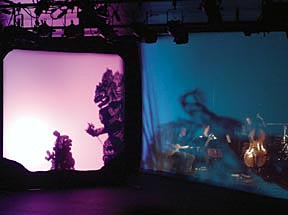 "ShadowBang" featured Balinese puppeteer Wyan Wija and the Bang on a Can All-Stars in their Boston debut. Photo by Timothy Suen, The Tech. |
The Boston Phoenix's Jeffrey Gantz included MIT's world premiere performance of "ShadowBang" by Professor Evan Ziporyn in his list of "Moving Performances: The Year in Dance." The collaborative performance by the New York-based Bang on a Can All-Stars and Balinese puppet-master I Wayan Wija "offered us the chance to laugh without irony or guilt for the first time in many weeks," wrote Gantz.
A Boston Globe feature, replete with color photos, described the List Visual Arts Center's Student Loan Program in a "Life at Home" column and interviewed students happy to have art in their lives. The article quotes biology doctoral student Sharotka Godzina, who said, "Art is rather important to students at MIT to maintain sanity and help us put things in a broader context."
The List Visual Arts Center's "YES Yoko Ono" exhibition, which came to the List Center as part of a six-city US tour, won the 2000–2001 International Association of Art Critics/USA Awards for best museum show originating in New York City.
Kathleen Goncharov, MIT's new public-art curator, was profiled by art writer/critic Christine Temin in the Boston Globe. "Goncharov has arrived amid a flurry of creation as new public pieces are commissioned in conjunction with MIT's 11 major construction projects. The Institute was praised both for its Art on Campus program which allots one percent of a construction project's budget to public art (with a $250,000 cap per project), and for choosing artists through a committee "steered by art-savvy experts."
The List Center's curator, Bill Arning, also was highly visible in the Boston media. Boston Magazine featured him in an article on "artist-friendly developments in Boston," calling him "foremost" among curators who know Boston artists. "Curators from around the world call Arning to ask him about the Boston art scene," wrote Stephen Jermanok. "If by chance they're in town, Arning will drive them around to his favorite galleries… 'One of the reasons I took this job is that a large percentage of your audience is students,' [Arning] says. 'If we do a good, edgy show here, something that engages them, then that's a particularly exhilarating position to be in.'"
The Boston Herald's Mary Sherman called "AA Bronson: Mirror Mirror," at the List Visual Arts Center, "less an art show than a meditation on life, loss and perseverance." The Boston Globe's Cate McQuaid wrote, "The show is strong, even brazen, in its unerring challenge to the viewer to face not only mortality but also the cruelty that humans inflict on one another.… It works well not simply because it confronts, but because Bronson provides us, through his reflections, flashbacks, dreams, and hopes, with a soft place to fall."
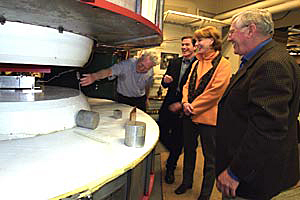 Ulrich Becker, MIT professor of physics, left, shows MIT's cyclotron to actors Hank Stratton, Mariette Hartley, and Len Cariou on May 7. Photo by L. Barry Hetherington. |
Broadway-in-Boston came to MIT—first as the cast of "Copenhagen" toured MIT's cyclotron, built when nuclear physics was just being developed, and later to join a panel of renowned physicists discussing "New Thoughts on Interpreting 'Copenhagen,' " moderated by associate provost for the arts Alan Brody. An overflow crowd in Wong Auditorium was attracted by the science, the drama, and extensive coverage in the Boston Globe's theater articles, and the "Names" and "Go!" columns. The event was organized by the MIT Office of the Arts and Boston's Goethe Institut and engineered by Brian Schwartz of The Graduate Center, City University New York. Requests for documentation of the event resulted in a web site of the proceedings, put together by Lynn Heinemann, at http://web.mit.edu/arts/CopenhagenSymposium.html.
"Many people who go to the MIT Symphony's concerts have probably thought to themselves: This orchestra must have a higher collective IQ than any other," began Richard Buell's Boston Globe review of MITSO's Dec. 8, 2001 concert. "Bright, conscientious, spirited performances are the ensemble's proven norm. Saturday night at Kresge Auditorium you also got the distinct impression—not for the first time—that the thornier the assignment, the better this group likes it." Buell also praised Professor Peter Child's "Jubal," which the orchestra performed, as "feisty, inventive, highly colored and purposeful." He continued, "In a juster world, 'Jubal' would immediately be making its way onto the major-league big-orchestra circuit."
Lloyd Schwartz of the Boston Phoenix called the MIT Symphony Orchestra's May 11 performance of Krzysztof Penderecki's Viola Concert, with guest artist Marcus Thompson, "one of the most stirring events of the season." The review praised Thompson's sound as "full, rich, and extremely complex; he has a rhythmic backbone, an edge, even when his tone is most gorgeous and velvety" and said, "Anzolini … guided the superb MIT players through the tricky Stravinskyan rhythms, the emotional swerves, the kaleidoscopic changes of color and texture."
In addition, MIT arts faculty received media attention for their work off campus, including:
- Professor Evan Ziporyn for his latest CD, "This is Not a Clarinet."
- Music and Theater Arts lecturer Laura Harrington for her play "Hallowed Ground."
- Professor Ellen Harris for her provocative new book Handel as Orpheus: Voice and Desire in the Chamber Cantatas.
- Institute Professor John Harbison for the Metropolitan Opera's revival of his opera "The Great Gatsby."
- Assistant professor Michael Hawley of the Media Lab for his top prize in the Van Cliburn Foundation's Third International Piano Competition for Outstanding Amateurs, held in Fort Worth, Texas.
- Professor Marcus Thompson for his last-minute role as substitute violist with the Lydian String Quartet
- Musician and film composer Jamshied Sharifi (S.B. 1983) as one of a dozen artists who created and recorded new works for National Public Radio's "A Requiem Soundscape" commemorating the one-month anniversary of the 9/11 tragedy.
- Professor Anzolini for his guest appearance with the Choral Arts Society of Washington, DC.
- Professor Tod Machover for his opera "Resurrection" (libretto by Lecturer Laura Harrington).
More information about the Office of the Arts can be found on the web at http://web.mit.edu/arts/.
Special Programs
Special Programs began its twelfth year of developing diverse programs with MIT departments.
Special Programs Sponsorship
In addition to Institute support, Special Programs received support from the Council for the Arts at MIT, the William L. Abramowitz Fund, the Ida Ely Rubin Fund for Arts and Technology, the Alan H. Katzenstein Memorial Fund, the Peter DeFlorez Fund for Humor, the John S. and James L. Knight Foundation, the List Visual Art Center, the LEF Foundation, and the MIT-Italy Program.
Artist-in-Residence Advisory Board
In its fifth year, the Advisory Board under the leadership of Steve Memishian (G) '70 welcomed new membership and was reminded of its mission:
The Artist-in-Residence (AIR) Program in the MIT Office of the Arts develops innovative opportunities for students and other members of the MIT community to interact with leading artists from around the world. The Program integrates artists into MIT's existing curricula in the arts and humanities, science, engineering, and management. It also works with faculty to develop curricula around the artist's visit to encourage creative thinking and expression within the MIT educational experience, while broadening students' artistic experience. Consistent with MIT's overall mission, the program recognizes and actively engages issues of diversity as a vital part of the cultural life of MIT.
Meetings were held on September 24, 2001, and April 29, 2002. The February 2002 meeting was cancelled.
Artist-in-Residence Advisory Board Subcommittees
The William L. Abramowitz Program became program partners with Comparative Media Studies. A Faculty Subcommittee including Professors Henry Jenkins, Ellen T. Harris, Evan Ziporyn and acting director Michael Ouellette was formed to develop long-range plans. Julie Taymor, director and stage designer, and the Pulitzer Prize-winning cartoonist Art Spiegelman were nominated, along with other celebrated artists such as Mark Morris, Ang Lee and Jim Schamus, Don Byron, collaborators Nick Bantock and Alex Mayhew, and Ming Cho Lee. The long-range plan will provide greater flexibility in development and scheduling.
The Ida Ely Rubin Artist-in-Residence Fund and the List Visual Art Center sponsored Paul Pfeiffer, digital video and mixed media installation artist, from September 18 to 20, 2001. Programs were developed with the Media Lab, Comparative Media Studies, the Visual Arts Program, and the Athletics Department. Pfeiffer investigated three-dimensional printing with Professor Michael Cima and his students in Materials Science and Engineering and developed future engagements with principal research scientist Michael Bove in the Media Lab. A fall 2002 program is planned.
The Ida Ely Rubin Subcommittee, including Ida Ely Rubin and Claire Montgomery, executive director of Location One, made plans to meet at Location One along with Jane Farver, director of the List Visual Art Center, and Maureen Costello, director of Special Programs, to review and select the next visiting artist in Arts and Technology.
In collaboration with Comparative Media Studies and with MIT support from the Alan W. Katzenstein Memorial Fund, the Advisory Board nominated filmmaker, director, and writer Kasi Lemmons for a program to be held on November 7, 2002. The Advisory Board nominated choreographers Eiko & Koma for an April 3, 2003, program.
School of Humanities, Arts, and Social Sciences
The Theater Section, the Visual Arts Program, and the Women's Studies Program supported Conway & Pratt Projects, Inc's visual and theatrical installation "A Woman's Work Is Never Done: a house of curiosities." A recruitment party was held where the artists presented their work to students and communicated possibilities for student involvement. The installation ran from September 19 to October 14, 2001, at 71 Amory Street in Jamaica Plain. A UROP student assisted prior to and during the open hours. Council for the Arts scholars visited the installation on the evening of October 12. Six courses from the Women's Studies Program involved their students. "A Woman's Work Is Never Done: a house of curiosities" was presented in collaboration with The Bostonian Society, Women's Educational and Industrial Union, and the LEF Foundation New England.
The 2001 William L. Abramowitz Program brought Moisés Kaufman, playwright and artistic director of the Tectonic Theater Company, to MIT from October 2 to 4, 2001. Preparation for this program included the distribution of copies of Kaufman's "Gross Indecencies: The Three Trials of Oscar Wilde" and "The Laramie Project,which were also made available to the public, all MIT students, and members of the Residency Advisory Board. "An Evening with Moisés Kaufman" was held in Wong Auditorium. Special guests included Kenneth and Nira Abramowitz.
A significant international collaboration was realized with "Shadow Bang, Balinese Puppetry Meets New Music," with Professor Evan Ziporyn, Balinese puppeteer I Wayan Wija, and the performance ensemble Bang on a Can All-Stars. The world premiere of "Shadow Bang" took place at MIT on October 9, 2001, in the Kresge Little Theater. Discussions with the artists were held after matinees and evening performances. Artists participated in workshops with Gamelan Galak Tika and students in Music and Theater Arts.
Sergio Escobar, administrative director of Milan, Italy's Piccolo Teatro, was invited by associate provost for the arts Alan Brody and Theater Arts professor Janet Sonenberg to offer a public discussion on "Science and the Theatre" and work with students in Theater Arts. Additional sponsorship was provided by the MIT-Italy Program.
School of Architecture
The 2001 Eugene McDermott recipient Isaac Julien, filmmaker and installation artist, received an award at the DeCordova Museum in Lincoln in October 2001. He returned to MIT in the spring to work with Visual Arts Program professor Joan Jonas. Council for the Arts member Marjorie Jacobsen introduced Mr. Julien at a screening of "Badassed Cinema," a commentary on the Blaxploitation films of the early 1970s. Council for the Arts scholars and Comparative Media Studies graduate students attended the screening, a reception at Senior House, and dinner at Legal Sea Foods with the artist.
In Media Arts and Sciences, Diane Willow, sound and environmental artist, completed her final year as artist in residence in collaboration with associate professor Mitchel Resnick of the Media Lab's Epistemology and Learning Group. "SEAt," with new six-foot drumheads, and "Clearing the Air Project," a sculpture featuring three eight-foot coils with sensors that respond to sound waves and harmonic resonance, will be sited in Fall 2002.
School of Science
Science photographer Felice Frankel completed her final year with Residence Program support and will continue as a science researcher.
School of Engineering
Peter Houk, artistic director of the MIT Glass Lab, presented the history of glass blowing to the AIR Advisory Board on September 24, 2001. Mr. Houk's residency supported his work at the MIT Glass Lab. Mr. Houk and his colleagues implemented The Great Glass Pumpkin Patch on the Kresge Oval.
Arthur Ganson, kinetic sculptor, withdrew from the Residence Program.
List Fellowship Program in the Arts
The List Foundation Fellowship Program in the Arts for students of color continued with support from the John S. and James L. Knight Foundation.
Carolyn Beth Chen '02 and Melissa Edoh '02 received fellowships to support digital videography and training in the Sabar drumming and Gumboot dance traditions of Senegal. "Story@MIT" will recruit volunteers for Ms. Chen's summer project. Programs for Fall 2002 and IAP were developed.
Talia Kingsbury '01, a mechanical engineering and creative writing graduate, will publish a chapbook, "Origin/Destino." A reading will be held in Killian Hall on September 13, 2002.
Vince E. Carballo '02, mechanical engineering, installed a mixed-media installation entitled "Lost Sons" in the Wiesner Gallery in December 2001. Rigel Stuhmiller withdrew from the program.
Several changes were made in the List Program:
- It will be available to sophomores and juniors only
- A fixed one-year schedule was established
- An e-mail list, artsfellowship@mit.edu, was created to make the program more accessible
- Two informational meetings for prospective applicants will be held in September
Staffing Changes
Amy Sanford, administrative staff assistant, moved to the Graduate Admissions Office, and Meredith Cutler was hired. The job of administrative staff assistant was re-evaluated to include coordination of the Freshman Arts Seminar Advising Program. A senior staff assistant position was created.
Maureen Costello finished as director of Special Programs in June 2002.
More information about Special Programs in the Office of the Arts can be found on the web at http://web.mit.edu/arts/special_programs/.